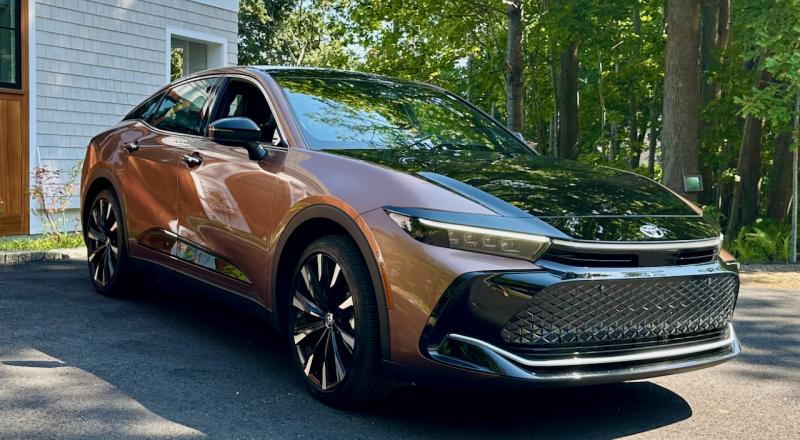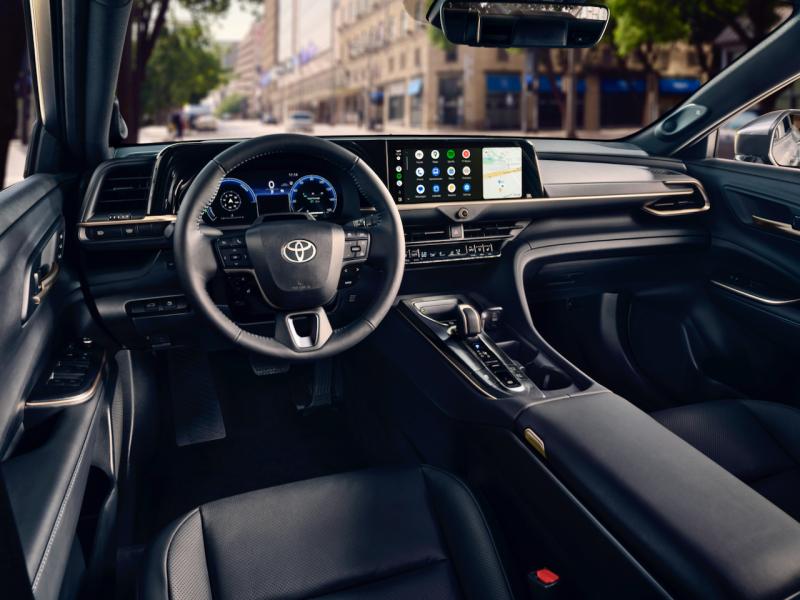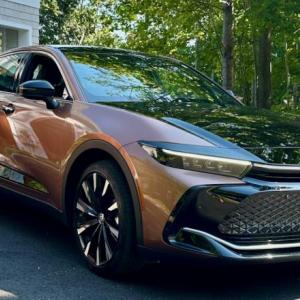A Conundrum: Toyota Crown Platinum
 That’s a Toyota? Something of a mystery sedan, the Crown glides through traffic, drawing notice because of its sleek shape and this handsome two-tone finish called Bronze Age over Black. Nightshade is a new color and trim level for 2025.
That’s a Toyota? Something of a mystery sedan, the Crown glides through traffic, drawing notice because of its sleek shape and this handsome two-tone finish called Bronze Age over Black. Nightshade is a new color and trim level for 2025.
 With switches and automation everywhere, mood lighting, a panoramic power sunroof and “Hey, Toyota!” voice assistance, the Crown Platinum’s cabin lacks nothing in the way of comforts and conveniences, but it falls short of Lexus levels of luxury. The leather doesn’t look like leather.
With switches and automation everywhere, mood lighting, a panoramic power sunroof and “Hey, Toyota!” voice assistance, the Crown Platinum’s cabin lacks nothing in the way of comforts and conveniences, but it falls short of Lexus levels of luxury. The leather doesn’t look like leather.
 That’s a Toyota? Something of a mystery sedan, the Crown glides through traffic, drawing notice because of its sleek shape and this handsome two-tone finish called Bronze Age over Black. Nightshade is a new color and trim level for 2025.
That’s a Toyota? Something of a mystery sedan, the Crown glides through traffic, drawing notice because of its sleek shape and this handsome two-tone finish called Bronze Age over Black. Nightshade is a new color and trim level for 2025.
 With switches and automation everywhere, mood lighting, a panoramic power sunroof and “Hey, Toyota!” voice assistance, the Crown Platinum’s cabin lacks nothing in the way of comforts and conveniences, but it falls short of Lexus levels of luxury. The leather doesn’t look like leather.
With switches and automation everywhere, mood lighting, a panoramic power sunroof and “Hey, Toyota!” voice assistance, the Crown Platinum’s cabin lacks nothing in the way of comforts and conveniences, but it falls short of Lexus levels of luxury. The leather doesn’t look like leather.
Not often do passers-by stop on the sidewalk to admire a parked Toyota, but it happened twice with this car, thanks to the Crown’s rich, distinctive colors and svelte shape. People walked all the way around it, leaning down to look inside and pointing to the Texas-issued “manufacturer” license plate. (TMNA, Toyota Motor North America, is headquartered in Plano.)
What is this thing, Ralphie?
I dunno—never heard of a Crown.
It’s a looker, innit? ‘Specially for a Toyota—my wife would love this thing!
Check out the license plate! Wonder who’s driving it? Man, we’re a long way from Texas.
Hey, doesn’t Toyota make some sorta hydrogen car?
And so on and so forth (I imagine). It’s not Toyota’s hydrogen-fueled EV—that’s the Mirai, which is available in the only part of the U.S. with hydrogen refueling stations, Southern California. Nor is it a prototype; Toyota has been selling this car, its new flagship, here for more than a year now. Americans did not fall in love with its predecessor, the Avalon, which departed in 2022, and so far the Crown hasn’t made much of an impression either, although I have now seen two others out in the wild, so to say.
Toyota refers to the Crown as a “lift-up sedan,” meant to bridge the gap between car and SUV, as one of the high-riding latter’s attractions is better visibility. However, until I browsed the press handouts, which point out that the Crown stands 60.6 inches tall on 21-inch wheels, I failed to notice any extra ride height.
The Crown also bristles (quietly) with sophisticated engineering—active suspension and torque distribution systems, five driving modes, and safety and connectivity apps galore. Platinum trim even includes dynamic rear-wheel steering—on the highway, the rear wheels turn very slightly with the front wheels, to aid in lane changes, and in the opposite direction at low speed, to reduce the turning circle for maneuverability. (Ahem, I failed to notice this, as well.)
Platinum Crowns get the Hybrid Max powertrain, with a 2.4-litre turbocharged engine and an electric motor on each axle. Together, they make 340 horsepower and 400 pounds-feet of torque, which produce plenty of acceleration, especially from rest, when the electric motors instantly hit full output. But our gas mileage was a disappointing 31 MPG; I was expecting something closer to the hybrid Camry’s 45 MPG. The optional less-powerful THS (Toyota Hybrid System) engine combo, rated for 236 horsepower, delivers about 41 miles per gallon.
All four Crown trim levels come with all-wheel drive, but the Hybrid Max setup has a direct-shift 6-speed automatic transmission and (courtesy of a transfer case) full-time AWD that is rear-wheel-biased. It varies the power split rear:front from 80:20 to 70:30, depending on driving conditions. THS Crowns, on the other hand, have on-demand all-wheel drive; the rear electric motor comes alive and powers those wheels only when extra traction is needed. Here, the front:rear torque split varies from 100:0 to 20:80, depending on conditions. THS Crowns have a continuously variable computer-controlled CVT automatic transmission.
Especially in bronze over black, the Crown looks like a million bucks—but does it look like $55,000? This is a real consideration for buyers, especially those (probably most of us) who are swayed by the snob appeal of a badge: Do we buy a pricey Toyota—or, for the same money, a Lexus? For 2025, the Crown starts at $42,575 for the entry-level XLE trim and proceeds upward to the Limited, at $47,085 and the $49,900 Nightshade before reaching the Platinum, which begins at $56,125.
These prices compare with, and in some cases exceed, those of a Lexus ES sedan. I haven’t driven an ES lately, but at least in memory that cabin is swankier than the Crown’s. As well, despite its powerful, high-tech drivetrain and suspension, and both Sport and Sport+ drive modes, the Platinum Crown still feels a bit ponderous. It’s a conundrum.
Next week: Mazda MX-5 Miata
























